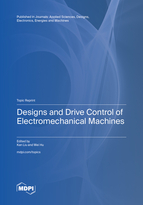Topic Menu
► Topic MenuTopic Editors


Designs and Drive Control of Electromechanical Machines

A printed edition is available here.
Topic Information
Dear Colleagues,
Electrical machines, which can be configured with different power ratings while maintaining superiorities of high efficiency and high power density, have been widely employed in various industry sectors, such as high-speed trains, industrial robots, wind power generation, and electric vehicles. For traction control systems, advanced solutions such as less rare-earth and rare-earth free machines, permanent magnet synchronous reluctance machines, in-wheel machines, and multi-phase/multi-three-phase machines have been widely investigated by both academia and industry. For high-accuracy-demanded drive systems, advanced solutions such as voice coil machines, linear machines, and ultra-high-speed spindle motors have been developed prosperously. As a result, numerous new materials, manufacturing and processing technologies, advanced topologies, and optimization techniques for electrical machines have been developed in recent years.
Meanwhile, as key equipment for electromechanical energy conversion, electrical machines also need corresponding drive and control schemes to guarantee their dynamic and steady-state performances. Therefore, a great number of advanced drive control schemes have been proposed in recent years for meeting the advanced control demands of electrical machines, such as lower switching losses, better fault tolerance and real-time condition monitoring, fewer sensors, parameter identification, and real-time observation.
To collect the latest developments in electrical machines and drives, we are pleased to invite the research community to submit review or regular research papers on, but not limited to, the following relevant topics:
- Multi-phase and in-wheel machines.
- Reliability design of machine drive systems.
- New topologies of electrical machines.
- Advanced optimization techniques for electrical machines.
- Applications of new materials in electrical machines.
- Cooling systems and insulation solutions for giant and high-voltage electrical machines.
- Underwater motor and sealing designs.
- Magnetic gears and magnetically geared machines.
- Drivers and power converters for more-electric vehicles, ship propulsion, and airplanes.
- Sensored and sensorless control of electrical machines.
- Fault-tolerant schemes for electrical machines.
- Condition monitoring and perception techniques for electrical machine systems.
- Testing methods and parameter identification methods for electrical machines.
- Distributed and fault-tolerant drive controls for electric vehicles and other special vehicles.
Prof. Dr. Kan Liu
Dr. Wei Hu
Topic Editors
Keywords
- electrical machines
- topologies
- condition monitoring and fault diagnosis
- permanent magnets
- drive controls
- power converters
- sensorless control
- parameter identification
Participating Journals
| Journal Name | Impact Factor | CiteScore | Launched Year | First Decision (median) | APC |
|---|---|---|---|---|---|

Applied Sciences
|
2.5 | 5.5 | 2011 | 19.8 Days | CHF 2400 |

Designs
|
- | 4.8 | 2017 | 18.3 Days | CHF 1600 |

Electronics
|
2.6 | 6.1 | 2012 | 16.8 Days | CHF 2400 |

Energies
|
3.2 | 7.3 | 2008 | 16.2 Days | CHF 2600 |

Machines
|
2.5 | 4.7 | 2013 | 16.9 Days | CHF 2400 |

Preprints.org is a multidisciplinary platform offering a preprint service designed to facilitate the early sharing of your research. It supports and empowers your research journey from the very beginning.
MDPI Topics is collaborating with Preprints.org and has established a direct connection between MDPI journals and the platform. Authors are encouraged to take advantage of this opportunity by posting their preprints at Preprints.org prior to publication:
- Share your research immediately: disseminate your ideas prior to publication and establish priority for your work.
- Safeguard your intellectual contribution: Protect your ideas with a time-stamped preprint that serves as proof of your research timeline.
- Boost visibility and impact: Increase the reach and influence of your research by making it accessible to a global audience.
- Gain early feedback: Receive valuable input and insights from peers before submitting to a journal.
- Ensure broad indexing: Web of Science (Preprint Citation Index), Google Scholar, Crossref, SHARE, PrePubMed, Scilit and Europe PMC.

